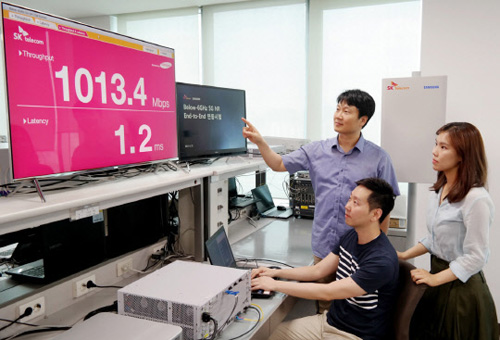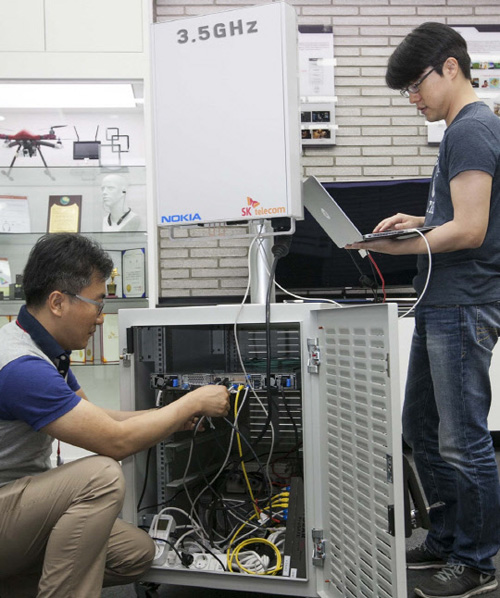SKT to have succeeded in 5 G test within 3.5㎓ broadband first in Korea
Jung Yoon Hee | yuni@ | 2017-06-29 10:15:39

SK Telecom and Samsung Electronics researchers are demonstrating 3.5GHz band communication with 3GPP 5G standard based communication equipment in the laboratory of Suwon site of Samsung Electronics on June 27. Photo by SK Telecom

SK Telecom and Samsung Electronics researchers are demonstrating 3.5GHz band communication with 3GPP 5G standard based communication equipment in the laboratory of Suwon site of Samsung Electronics on June 27. Photo by SK Telecom
SK Telecom has revealed on June 28 that it succeeded in testing 5G (G) mobile communication using 3.5GHz frequency band together with Samsung Electronics and Nokia.
The 5G frequency is classified into the ultra-high frequency and the low-frequency band. The low-frequency band 3.5GHz has a smaller data transmission rate than the high-frequency band, but it has a long propagation distance and a fast transmission speed.
Currently, global mobile operators are trying to acquire 5G technology focusing on ultra high frequency (millimeter wave) such as 28GHz.
The ultra-high frequency band is advantageous for large-capacity data transmission using a wide bandwidth, but there is a limit in that the reaching distance is relatively short due to strong directivity of the radio wave.
As a result, China, Japan, and Korea have focused on securing 5G technology at frequencies below 6GHz, which is able to speed up communication while expanding the speed of giga.
The company jointly developed base station equipment, test terminals, and virtualization core equipment using 3.5GHz frequency band based on 3GPP 5G standard in cooperation with Samsung Electronics.
The two companies succeeded in demonstrating using 5G standard specification technology such as channel coding technology (LDPC) and ultra-low delay communication technology which minimized the data loss rate in the laboratory of Samsung Electronics Suwon site the day before.
On that day, SK Telecom announced that it has succeeded in realizing the speed of gigabit speed in the vicinity of the building of Bundang SK Telecom by jointly developing with Nokia 3.5GHz 5G base station equipment and test terminal.
The two companies have added frequency banding technology (Carrier Aggregation) to extend bandwidth. It is a measure service speed and quality on the move, and gained actual data for the future 3.5GHz network construction.
SK plans to operate 28GHz in urban areas and 3.5GHz in other areas where the data transmission volume of 5G is commercialized, or to construct a 28GHz combined network.
The company plans to use 3.5GHz for services that require stable communication such as 28GHz for autonomous reality (AR) media services and self driving car and disaster recovery robots, which require large amounts of data.
SK has already developed 28㎓ broadband 5G test network in Seoul, Gangnam, Gyeonggi province, Bundang, Incheon and Youngjoungdo.
By Jung Yoon Hee yuni@
